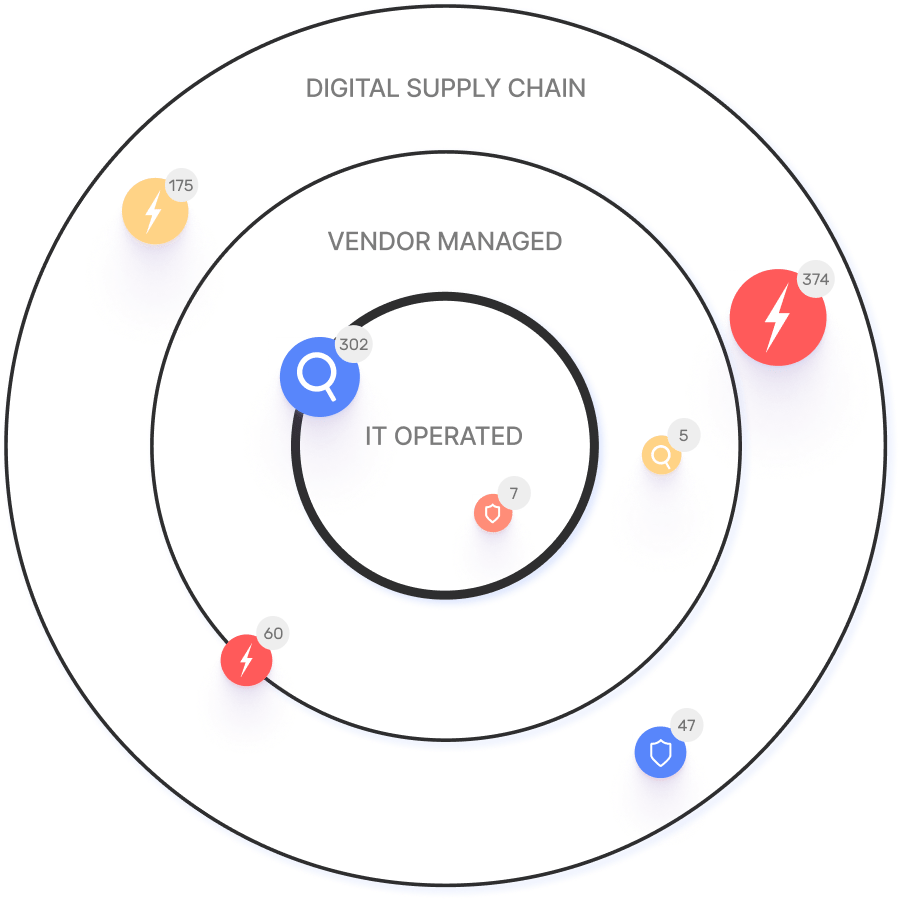Web application security is the practice of defending web applications, websites, and web application programming interfaces (APIs) against potential cyber threats. These threats include everything from exploiting vulnerabilities in these applications to taking advantage of security misconfigurations to abusing incorrect business logic.
In this article
Web application security is vitally important to a corporate security program because these web applications and APIs are commonly exposed on the public Internet. At the same time, they also have the ability to access highly sensitive customer and corporate data. This combination makes them a common target for cybercriminals, and vulnerabilities and misconfigurations can lead to data breaches or other high-impact security incidents.
Managing these risks requires a comprehensive web application security program. Key components include secure development practices, web application security controls, and regular application security testing throughout the software development lifecycle (SDLC).
Top Web Application Security Risks
Web applications can fall prey to a variety of vulnerabilities, misconfigurations, and other security risks. Some of the top threats to web app security include:
- Injection Attacks: Injection attacks use malicious and malformed user-provided input to change the behavior of an application. For example, SQL injection (SQLi) attacks use crafted inputs designed to change the function of an SQL query to access additional data, modify database records, or destroy information stored within a database.
- Broken Authentication and Access Control: Authentication and access control are intended to validate a user’s identity and appropriately limit their access and privileges on a system. Broken authentication and access control code may allow an attacker to masquerade as a legitimate user or permit access to resources or data that a user shouldn’t be able to access.
- Cryptographic Failures: Cryptographic algorithms are used to authenticate users’ identities and prevent unauthorized access to sensitive data. Failing to use, misusing, or using broken cryptographic algorithms can undermine the protection that these tools can provide and leave an application vulnerable to attack.
- Cross-Site Scripting (XSS): XSS attacks attempt to inject malicious scripts into the code of a webpage. By doing so, they can harvest user credentials, payment card data, or other sensitive information input into the page by its users.
- Cross-Site Request Forgery (CSRF): A CSRF attack targets users who are already logged into a web application while browsing another webpage. By tricking the user’s browser into making a request to the logged-in web app, the attacker may be able to perform malicious actions, such as changing the user’s password, if the appropriate security controls are not in place.
- Server-Side Request Forgery (SSRF): SSRF attacks attempt to trick a vulnerable web application into making requests on an attacker’s behalf. For example, a vulnerable application may be able to fetch a webpage and return the results to a user, while a direct request from the attacker would be blocked by a firewall or access control list.
- Denial of Service (DoS): DoS attacks attempt to degrade an application’s performance or take it down entirely, often by flooding it with more traffic than it can handle. Distributed DoS (DDoS) attacks do so by using a botnet of compromised machines working in concert to send large volumes of traffic while evading IP blocks and similar preventative controls.
- Remote Code Execution (RCE): RCE vulnerabilities allow an attacker to execute malicious code on the web server hosting a vulnerable application. For example, a command injection vulnerability might permit the attacker to execute malicious commands within the system terminal.
- Security Misconfigurations: Security misconfigurations are risks introduced by how an application is deployed and set up in a production environment. For example, a web application could be deployed without changing the default password for the administrator account, making it easy for an attacker to guess the password and gain privileged access to the system.
- Insecure Design: Design vulnerabilities involve a failure to build proper security controls into an application’s design. For example, a login page without proper rate limiting in place may be vulnerable to credential stuffing or DoS attacks.
Tools You Can Use to Defend Against Web Application Threats
Web application security is vitally important due to these apps’ public exposure and access to sensitive information and privileged functionality. Various tools are available to help organizations develop, deploy, and test secure web apps and APIs, including the following:
- Web Proxy: Web proxies like OWASP Zed Attack Proxy (ZAP) are tools that allow web traffic to be intercepted and modified between a client system and a web server. These are invaluable for examining web traffic for security risks or testing if an application is vulnerable to certain attacks.
- Static Application Security Testing (SAST): SAST tools inspect application source code for code patterns associated with certain types of vulnerabilities, such as injection. They can be integrated into automated CI/CD pipelines to help detect potential security issues early in the development process.
- Dynamic Application Security Testing (DAST): DAST solutions work on running applications, sending them malicious, malformed, or random inputs in an attempt to trigger potential vulnerabilities. Like SAST, they can be built into CI/CD pipelines to permit automated testing throughout the SDLC.
- Software Composition Analysis (SCA): SCA tools map out the third-party code included in an application via imports, libraries, and dependencies. This enables developers to identify vulnerable and out-of-date external code that may be exposing an application to attack.
- Web Application Firewall (WAF): WAFs are firewalls that specialize in identifying and blocking attacks targeting web applications. They provide protection for deployed web apps against injection and other common web app vulnerabilities.
- Configuration Management: Misconfigurations are a common error that can leave web apps vulnerable to exploitation. Configuration management tools continuously monitor for insecure configurations, enabling an organization to quickly act to close these security gaps.
- Infrastructure as Code (IaC): IaC is a development practice in which deployment and configuration processes and settings are implemented as code. This helps to ensure consistent application configurations and protects against vulnerabilities caused by human error.
Web Application Security Best Practices
Web applications can be vulnerable to various security threats that arise throughout the SDLC. Some security best practices that can help reduce a web application or API’s vulnerability to top cybersecurity risks include the following:
- Implement Security by Design: The principle of security by design states that security should be built into an application from the beginning rather than being included as an afterthought. Explicitly implementing security requirements and testing reduces the risk that vulnerable code will reach production, where it can be exploited by an attacker.
- Validate User Input: Some types of attacks, such as injection and XSS, may include malicious and malformed user input designed to cause a vulnerable application to misbehave. Validating user input before using it — using allowlists and schemas where possible — reduces an application’s vulnerability to these attacks.
- Encode HTML Output: XSS attacks involve embedding user-provided scripts in the HTML code of a webpage. Encoding all user-provided input before including it in an HTML page helps to defend against these threats.
- Encrypt Data at Rest and In Transit: Web applications should use HTTPS to encrypt and authenticate web traffic and enforce this by implementing HTTPS Strict Transport Security (HSTS). Additionally, sensitive data stored by the web application — whether locally or on database servers — should be encrypted to protect it against unauthorized access and potential breaches.
- Implement Rate Limiting: DDoS attacks, credential stuffing, and other automated attacks rely on the ability to make many requests in a short period of time. Rate limiting prevents these rapid-fire attacks, reducing the utility of these attacks.
- Automate Testing Throughout the SDLC: Security testing is often left until the Testing stage of the SDLC, leaving little time to correct identified issues before release. Automating testing throughout the SDLC by integrating SAST and DAST tools into CI/CD pipelines and automatically testing production systems dramatically reduces the risk of a successful cyberattack.
- Centralize Authentication and Access Management: Authentication and access management are critical to application security, and vulnerabilities in this code could leave the application and its users at risk. Centralizing all of this functionality in a single location reduces the risk of mistakes and simplifies the process of performing any necessary updates.
- Implement MFA and Least Privilege: Implementing multi-factor authentication (MFA) and the principle of least privilege (POLP) enhances the security of authentication and access control. MFA makes it more difficult for an attacker to successfully compromise a user’s account, while POLP limits the amount of damage that an attacker could do with access to the user’s legitimate access and privileges.
- Log Important Events: Web apps and APIs should be configured to log any significant and security-related events, such as failed authentication attempts. This provides a record that can be used to help identify and respond to an attack or reconstruct the chain of events in the wake of a security incident.
- Continuously Monitor Apps and Logs: In addition to logging important events, a security team should also continuously monitor these logs. Otherwise, the potential benefits of the logs are severely limited since the organization can’t act quickly on the information that they provide.
- Perform Regular Testing: As new vulnerabilities are discovered and threats evolve, an application previously believed to be secure might be found to be at risk. Continuous vulnerability scanning and regular penetration testing provide an organization with up-to-date visibility into its risk exposure.
Web Application Security Standards and Compliance
Web application security programs may be driven by both internal and external factors. Some of the top resources in the space and relevant laws and regulations include the following:
- OWASP Top Ten: The Open Web Application Security Project (OWASP) develops various resources for developers, including a top ten list of the most impactful vulnerabilities for web apps and APIs. The vulnerabilities on this list are the most common ones in web applications and also the first that many cyberattackers will search for within an application.
- Data Privacy Laws: Many jurisdictions have enacted general data privacy laws, such as the EU’s General Data Protection Regulation (GDPR). Web applications commonly contain personally identifiable information (PII) protected under these laws and must comply with the security and privacy requirements of applicable regulations.
- Industry-Specific Regulations: A company may also be subject to certain laws and regulations based on the types of data it collects or the industries that it operates in. For example, web applications that access payment cards must comply with the Payment Card Industry Data Security Standard (PCI DSS), and healthcare organizations in the U.S. are subject to the Health Insurance Portability and Accountability Act (HIPAA).
Securing APIs and the Modern Web Attack Surface
Historically, web application security efforts largely focused on web apps. These user-facing pages are more visible, making them a common target and a top-of-mind concern when implementing web application security efforts. However, APIs, which are designed to allow application-to-application communication, are a growing part of the modern web. APIs support mobile apps, websites, microservices, and other customer-facing systems and services.
Web APIs have many of the same vulnerabilities and security risks as web apps. For example, both are potentially vulnerable to credential stuffing attacks, but the design of web APIs makes them an easier target since they are designed to interact with automated scripts. However, web APIs also face security risks that are unique to them. For this reason, OWASP has a separate Top Ten list for APIs detailing the biggest threats to them.
When implementing a web application security program, it’s also important to consider APIs and their specific security risks. Including them in the scope of testing, implementing defenses against their unique threats, and deploying solutions that support web apps and APIs alike are vital components of an effective web application security strategy.
Embracing DevSecOps and CI/CD Integration
The practice of DevSecOps intentionally integrates security into DevOps processes and practices throughout the entire SDLC. Key elements of this include:
- Explicitly defining security-specific requirements during the planning process.
- Including security features and controls when designing an application.
- Following software security best practices when developing application code.
- Integrating automated testing tools, such as SAST and DAST, into automated CI/CD pipelines.
- Automating vulnerability scanning and testing for applications deployed to production environments.
Securing Web Applications with IONIX
Web applications, APIs, and webpages make up a substantial component of an organization’s external digital attack surface. These programs are prime targets for cyberattacks due to their access to highly sensitive data and functionality, and the fact that they are often publicly accessible.
A robust web application security program covers all of an organization’s web applications and provides up-to-date visibility into the organization’s cyber risk exposure. Accomplishing this requires extensive knowledge of potential web app security threats and continuous monitoring to identify new and emerging potential vulnerabilities.
The IONIX platform takes a threat-centric approach to identifying risks to the organization. With continuous scanning and attack simulations focused on the most common web app and API security threats, IONIX allows developers and security teams to work based on up-to-date security intelligence. To learn more about how IONIX can enhance your organization’s web app security, request a free demo.



